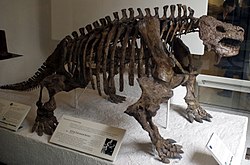Pareiasauria
| Pareiasauria | |
|---|---|

| |
| Skeleton of Scutosaurus karpinskii in the American Museum of Natural History | |
| Scientific classification | |
| Domain: | Eukaryota |
| Kingdom: | Animalia |
| Phylum: | Chordata |
| Class: | Reptilia |
| Clade: | †Parareptilia |
| Order: | †Procolophonomorpha |
| Node: | †Ankyramorpha |
| Suborder: | †Procolophonia |
| Clade: | †Pareiasauromorpha |
| Superfamily: | † Pareiasauroidea
|
| Clade: | †Pareiasauria Seeley , 1888
|
| Genera | |
| |
Pareiasaurs (meaning "cheek lizards") are an extinct clade of large, herbivorous
Description

Pareiasaurs ranged in size from 60 to 300 centimetres (2.0 to 9.8 ft) long, with some species estimated to exceed 1,000 kilograms (2,200 lb) in body mass.
Evolutionary history
Pareiasaurs appear very suddenly in the fossil record. It is clear that these animals are
Classification
Some paleontologists considered that pareiasaurs were direct ancestors of modern turtles. Pareiasaur skulls have several turtle-like features, and in some species the scutes have developed into bony plates, possibly the precursors of a turtle shell.[13] Jalil and Janvier, in a large analysis of pareiasaur relationships, also found turtles to be close relatives of the "dwarf" pareiasaurs, such as Pumiliopareia.[14] However, the discovery of Pappochelys argues against a potential pareisaurian relationship to turtles,[15] and DNA evidence indicates that living turtles are more closely related to living archosaurs than lepidosaurs, and therefore cladistically diapsids.[16]
Associated clades
Pareiasauroidea (Nopcsa, 1928): This clade (as opposed to the superfamily or suborder Pareiasauroidea) was used by Lee (1995) for Pareiasauridae + Sclerosaurus. More recent cladistic studies place Sclerosaurus in the procolophonid subfamily Leptopleuroninae (Cisneros 2006, Sues & Reisz 2008), which means the similarities with pareiasaurs are the result of convergences.
Pareiasauria (Seeley, 1988): If neither Lanthanosuchidae or Testudines are included in the clade, the Pareiasauria only contains the monophyletic family Pareiasauridae.
Phylogeny
Below is a cladogram from Tsuji et al. (2013):[17]
| Pareiasauria |
| |||||||||||||||||||||||||||||||||||||||||||||||||||||||||||||||
References
- ^ ISSN 2296-701X.
- ^ S2CID 257369904.
- S2CID 86503874.
- PMID 19416416.)
{{cite journal}}: CS1 maint: multiple names: authors list (link - .
- PMID 21238234.
- S2CID 6102313.
- ^ ISSN 0024-4066.
- ISBN 978-0198577058.
- .
- S2CID 85790423.
- .
- .
- ^ Jalil, N.-E.; Janvier, P. (2005). "Les pareiasaures (Amniota, Parareptilia) du Permien supérieur du Bassin d'Argana, Maroc". Geodiversitas. 27 (1): 35–132.
- S2CID 205243837.
- PMID 25450099.
- S2CID 86097405.
Further reading
- Carroll, R. L., (1988), Vertebrate Paleontology and Evolution, W.H. Freeman & Co. New York, p. 205
- Kuhn, O, 1969, Cotylosauria, part 6 of Handbuch der Palaoherpetologie (Encyclopedia of Palaeoherpetology), Gustav Fischer Verlag, Stuttgart & Portland
- Society of Vertebrate Paleontology (24 June 2013). "Pareiasaur: Bumpy beast was a desert dweller". ScienceDaily. Archived from the original on 2023-11-23. Retrieved 2024-03-01.
External links
- "Introduction to Pareiasauria: An Upper Permian group of Anapsids". Ucmp.berkeley.edu. Archived from the original on 2023-09-27.
- "Hallucicrania [Pareiasauriformes]". Mikko's Phylogeny Archive. Archived from the original on 2007-12-09.
- "Anapsida: Hallucicrania". Palaeos. Archived from the original on 2005-04-09.
